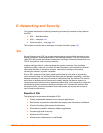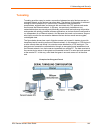
EDS Device Servers User Guide 141
C: Networking and Security
This chapter describes the following networking and security concepts as they relate to
the EDS:
SSL ⎯ described below.
SSH ⎯ see page 143
Serial tunneling ⎯ see page 144
This chapter concludes with a description of modem emulation (page 147).
SSL
Secure Sockets Layer (SSL) is an open-standard security protocol that provides privacy
through encryption, server authentication, and message integrity. From its introduction in
1994, SSL has become the industry standard for securing e-commerce transactions over
TCP/IP connections. And it is easy to see why.
Imagine mailing a letter in a clear envelope that anyone could see. If the envelope
contained a check, credit card, or other valuable information, some nefarious individual
could steal the letter or change its contents. Information traveling over networks,
including the Internet, is just as vulnerable.
Prior to SSL, packets of information would travel networks in full view of anyone who
could access the data. As the World Wide Web grew and gained in popularity, a solution
became necessary for securing e-commerce transactions over the Internet. The solution
would have to enable Internet consumers to reliably identify the Internet vendors (e-
commerce servers) with whom they transact business while, at the same time, protect the
confidentiality of the consumers’ sensitive information as it traversed the Internet. With
the advent of SSL, personal information that could be seen by anyone with access to
view it could now be secure.
Benefits of SSL
The following list summarizes the benefits of SSL:
Widely implemented standard for e-commerce applications
Reduces the complexities associated with keeping user information confidential
Works with existing Web servers and browsers
Eliminates the need for additional software applications
Provides high level of security
Platform and O/S neutral
Allows server authentication via certificates


















